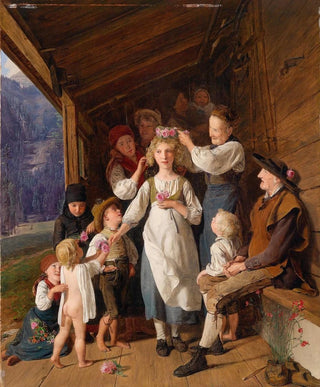Art print | Le Kranzljungfer - Ferdinand Georg Waldmüller Source: Reproduction | Le Kranzljungfer - Ferdinand Georg Waldmüller


View from behind

Frame (optional)
In the vast panorama of art history, some works stand out for their ability to capture moments of fleeting beauty. "The Kranzljungfer" by Ferdinand Georg Waldmüller is a perfect example. This painting, imbued with delicacy and poetry, transports us to the heart of a scene where nature and humanity meet in rare harmony. The depiction of a young woman, dressed in traditional attire and surrounded by flowers, evokes a celebration of rites and popular traditions. Through this artwork, Waldmüller invites us to contemplate the beauty of everyday life while revealing the subtleties of the human soul.
Style and uniqueness of the work
The aesthetic of "The Kranzljungfer" is characterized by the distinctive style of Austrian Romanticism, where light and color play a central role. Waldmüller, a true master of light, succeeds in creating a vibrant atmosphere that envelops the viewer. The meticulous details of the flowers and traditional costumes are executed with precision, reflecting a deep respect for nature and customs. The composition, balanced and harmonious, guides the eye toward the serene face of the young woman, symbol of purity and grace. Every element of the canvas, from the shimmering colors to the delicate expressions, contributes to a visual narration that invites us to feel emotion and the joy of living.
The artist and his influence
Ferdinand Georg Waldmüller, born in 1793, is one of the most influential artists of his time. Operating during a period when art was freeing itself from academic constraints, he distinguished himself by his ability to combine realism and romanticism. Waldmüller drew inspiration from daily life and popular traditions, seeking to immortalize simple yet meaningful moments. His work is a celebration of the beauty of the world, where each painting becomes a window into the human soul. As a pioneer of the naturalist movement, he paved the way for many artists who followed his example, aiming to represent reality with increased sensitivity. His influence endures, and "The Kranzljungfer" remains a

Matte finish

View from behind

Frame (optional)
In the vast panorama of art history, some works stand out for their ability to capture moments of fleeting beauty. "The Kranzljungfer" by Ferdinand Georg Waldmüller is a perfect example. This painting, imbued with delicacy and poetry, transports us to the heart of a scene where nature and humanity meet in rare harmony. The depiction of a young woman, dressed in traditional attire and surrounded by flowers, evokes a celebration of rites and popular traditions. Through this artwork, Waldmüller invites us to contemplate the beauty of everyday life while revealing the subtleties of the human soul.
Style and uniqueness of the work
The aesthetic of "The Kranzljungfer" is characterized by the distinctive style of Austrian Romanticism, where light and color play a central role. Waldmüller, a true master of light, succeeds in creating a vibrant atmosphere that envelops the viewer. The meticulous details of the flowers and traditional costumes are executed with precision, reflecting a deep respect for nature and customs. The composition, balanced and harmonious, guides the eye toward the serene face of the young woman, symbol of purity and grace. Every element of the canvas, from the shimmering colors to the delicate expressions, contributes to a visual narration that invites us to feel emotion and the joy of living.
The artist and his influence
Ferdinand Georg Waldmüller, born in 1793, is one of the most influential artists of his time. Operating during a period when art was freeing itself from academic constraints, he distinguished himself by his ability to combine realism and romanticism. Waldmüller drew inspiration from daily life and popular traditions, seeking to immortalize simple yet meaningful moments. His work is a celebration of the beauty of the world, where each painting becomes a window into the human soul. As a pioneer of the naturalist movement, he paved the way for many artists who followed his example, aiming to represent reality with increased sensitivity. His influence endures, and "The Kranzljungfer" remains a






